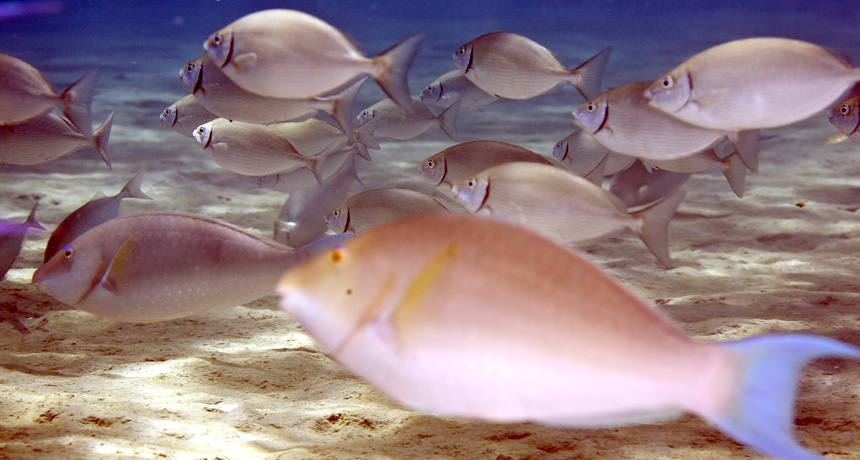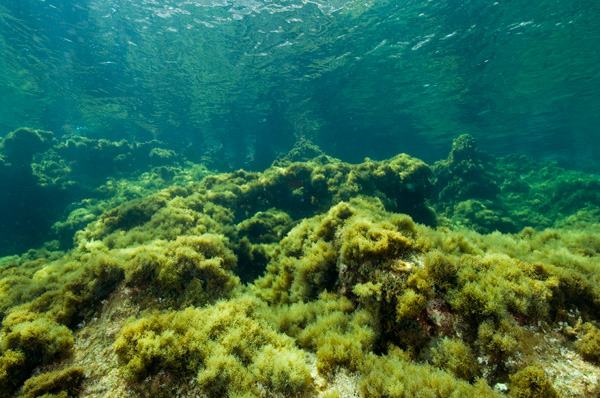
HERE FOR THE FOOD The marbled spinefoot is one of two rabbitfish species invading warming temperate waters in the Mediterranean and eating up native seaweed forests.
stephan kerkhofs/Shutterstock
- More than 2 years ago
Voracious tropical fish are working together to strip the Mediterranean seafloor of its algae forests. As climate change heats the sea basin, two rabbitfish species have invaded warming temperate waters to chomp both the adult and juvenile forms of algae, decimating the population, reports a study September 23 in the Journal of Ecology.
“It’s really quite eerie to dive in these areas where rabbitfish are abundant, because there’s just not that much in terms of the seascape,” says lead author Adriana Vergés, a marine ecologist at the University of New South Wales in Sydney. “They’re able to completely overgraze. What they’re doing when they get to these new areas has cascading impacts on the entire community.”
It’s an example, Vergés says, of what may be the most worrisome consequence of climate change: shifts in how species interact, which can ruin the integrity of a habitat such as the algal forests.
The algae forests of the Mediterranean are squat, often less than 20 centimeters tall. Yet they are as important to the marine ecosystem as trees are to terrestrial forests. Fish and invertebrates use the algae for food, shelter and nurseries for their young.
Rabbitfish originally made their way into the Mediterranean from the Red Sea through the Suez Canal. One species, known as the marbled spinefoot (Siganus rivulatus), was first spotted in 1927; the dusky spinefoot (Siganus luridus) appeared in 1956. Only now, however, as climate change warms the Mediterranean Sea, are the fish expanding their range into the temperate waters where algae forests grow.

To examine how the rabbitfish are affecting the algae forest and its inhabitants, Vergés and her colleagues surveyed waters along a 1,000-kilometer swath of coastline along Turkey and Greece. They measured sea surface temperature at 54 stations and counted up how many algae, fish and invertebrates they spotted during scuba dives.
As expected, warmer waters were more likely to have been invaded by the rabbitfish. In these areas, algae were around one-third as abundant as in areas without rabbitfish. There were also 60 percent as many species and the researchers estimated the rabbitfish areas carried just 40 percent as much overall biomass, a measure of the abundance of all living things.
Without the algae, many of the species that depend on them disappear as well. “If you look very closely there’s small snails, things happening on the small micro scale,” in areas where rabbitfish have eaten the algae forests, says Vergés. “There’s a lack of big fish or sponges.”
Additionally, to understand the invaders’ feeding habits, the team videotaped patches of algae in areas with and without rabbitfish, observing the fish that came to feed.
Vergés and her colleagues found that the rabbitfish did not actually eat more than the native species. Instead, one rabbitfish species targeted adult algae while the other grazed on the juvenile form sticking to the rocky ground. Meanwhile, native fish eat only adult algae. The combined effects of removing young and old algae allow the rabbitfish to leave barren seafloor in their wake, the researchers conclude.
Vergés and her team “have looked at how the animals are actually functioning in the system,” says Amanda Bates, a marine ecologist at the University of Southampton in England. “She’s not speculating how these different fish are influencing the system — she knows because she’s gone underwater, she’s watched them.”
Bates predicts, “People will pick up on this and even emulate this research in other studies.”.
Invasive species like the rabbitfish will keep expanding their ranges if people don’t curb carbon emissions, Vergés says. But in the meantime, people can try to minimize the impact of the fish by asking questions such as “Does it have any value to humans that we might exploit?” Bates says. “Can we eat it? Can we develop a fishery for this species?”
The rabbitfish are edible, says Fiona Tomas, a coauthor of the new study and a marine ecologist the Universidad de las Islas Baleares in Spain. In the overfished Mediterranean, rabbitfish even represent an economic opportunity. “In areas like Turkey, they are becoming one of the main artisanal fisheries,” she says.





